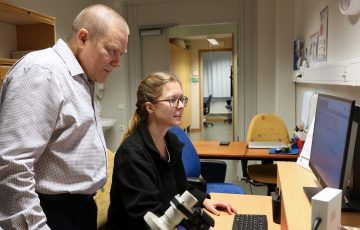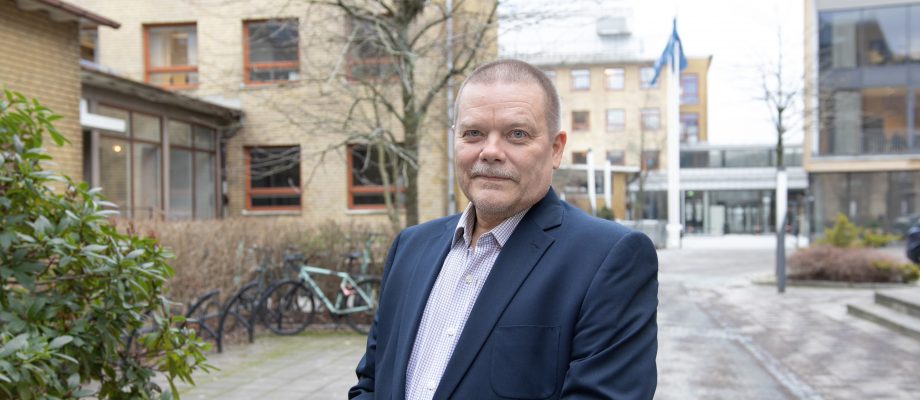RESEARCH. One Swede in ten has asthma but, despite medication, many fail to gain control of their disease. Now, new research shows that people with “T2-low asthma” get insufficient help from current treatment and that half of all asthma patients may belong to this group. Professor Hannu Kankaanranta of the Institute of Medicine is intent on finding out more.
Allergic asthma is the category studied most to date. The type 2 inflammation (“T2-high asthma”) characterizing it causes a raised count of eosinophil granulocytes (a type of white blood cells) in the patient’s respiratory tract. However, a high proportion of patients develop a kind of asthma in adulthood, known as “T2-low asthma,” that involves no allergy or eosinophils in the airways.
The purpose of Hannu Kankaanranta’s research project is to investigate what proportion of patients have T2-low asthma, who the people affected are, and which inflammatory mechanisms govern the disease.

“We’re also hoping to develop new methods to identify these patients and, in the longer term, define potential targets for new drugs,” Kankaanranta says.
His research project is part of the large West Sweden Asthma Study, which is based on survey responses from 42,000 Swedes and clinical examinations of more than 3,000 people.
400,000 Swedes may be affected
Today, much asthma can be treated effectively with bronchodilator medications and glucocorticoids, such as cortisone, which reduce inflammation. But a large group of patients get inadequate help from the current treatment. One reason may be that they have what is known as T2-low asthma.
This is a recently discovered subgroup of asthmatics. However, knowledge of how health care is to find these patients, and which treatment can provide better help for them, is lacking.
“We know that the onset of T2-low asthma occurs later in adulthood, causes more symptoms, and responds less well to treatment with cortisone preparations. We don’t know how many people have this form of asthma, but it may be as many as one in two asthma patients. In Sweden, between 800,000 and a million people have asthma, so a great number of people are affected,” Kankaanranta says.
Invisible group of patients
Today, the health care system can find patients with T2-high asthma by various means, such as measuring the quantity of eosinophils in the blood and the level of nitric oxide in patients’ exhaled air.
“If these tests show that a patient has high blood eosinophil counts, we know it’s T2-high asthma. On the other hand, if the counts are normal or low, it doesn’t automatically mean that the patient has T2-low asthma, since cortisone treatment lowers the inflammatory markers. This means that T2-low asthma isn’t visible, and we have no tools for finding these patients at present,” he says.
Asthma is a complex disease with many subgroups. What may trigger an asthma attack includes allergens, viral infections, and physical exertion, depending on the type of asthma concerned. Asthma severity is classified in five levels, depending on the severity of symptoms and how far disease control is achieved by means of treatment.

Photo: Karin Allander
Association with smoking and comorbidity
In recent years, several new biological drugs and antibody treatments have been developed that can substantially help patients with severe asthma, but these are efficacious only for patients with T2-high asthma. No good treatment is currently available for those with T2-low asthma, and the implications are particularly serious for patients who have a severe form of it.
“The current paradigm is that severe asthma is usually T2-high, but our data and data from several other research groups show that T2-low asthma is more common among patients with severe asthma than was previously thought,” Kankaanranta says.
Research also shows that T2-low asthma is associated with smoking, overweight, and comorbidities such as diabetes, cardiovascular disease, and depression.
According to Kankaanranta, knowledge about patients who have both asthma and other diseases is low. The same is true when it comes to asthmatics who smoke or have smoked for a long time in the past.
“In asthma studies, these people are often excluded, because you want ‘pure’ asthma patients, so that you can say with certainty that the disease mechanisms you find are due to asthma and not any other factor. It also means that little is known about how asthma and other diseases interact.”
New treatment guidelines necessary

A respiratory tract disease caused by chronic inflammation. In Sweden, an estimated 10 percent of the population lives with asthma, and 5–10 percent of these people have severe asthma.
Asthma is due to many factors, such as genetics, age, lifestyle, environment, and comorbidities. Its onset may occur both in children and in adults up to an advanced age.
The disease is traditionally divided into non-allergic and allergic asthma. Recent research has shown that there are also various phenotypes, two main groups being T2-high and T2-low asthma.
Asthma is investigated and treated in primary care. If the patient is difficult to diagnose or has severe symptoms, treatment can also take place in the specialist care services.
An asthma attack can be life-threatening. According to Sweden’s National Board of Health and Welfare, 141 adults died in Sweden from asthma, or acute severe asthma, in 2020.
T2-low asthma may also contain additional subgroups, one of which is thought to be associated with smoking. This means that it may be necessary to find several targets for new drugs. Developing new medicines is a lengthy process, and included in Hannu Kankaanranta’s own experience. Originally a doctor, he began his clinical specialization in clinical pharmacology and drug therapy, and his research career in pharmacology.
Initially, his research was on rheumatoid arthritis, which is also an inflammatory disease. However, after gaining his doctorate he became interested in inflammatory processes linked to pulmonary medicine. Today he is also a specialist doctor in pulmonary medicine and allergology, and Professor of Pulmonary Medicine at Tampere University, Finland. He was recruited to the University of Gothenburg (GU) in 2020.
“Developing new medicines takes a long time. At best, we’ll have new medicines for T2-low asthma in ten years’ time. But if we can help health care by providing tools for finding these patients and developing better treatment guidelines, then we’ve made good progress,” he says.
Active at the Krefting Research Centre
Kankaanranta works at the Krefting Research Centre, GU’s center for asthma and allergy research. This center is financed largely by the Herman Krefting Foundation for Allergy and Asthma Research.
The T2-low asthma project, which is being conducted by several researchers at the Krefting Research Centre, is funded by the Swedish Research Council, the Swedish Heart Lung Foundation, the Swedish Asthma and Allergy Association and ALF Västra Götaland.
Read more about Hannu Kankaanranta here.
TEXT AND PHOTO
: KARIN ALLANDER











